brakes OLDSMOBILE SILHOUETTE 2003 Owners Manual
[x] Cancel search | Manufacturer: OLDSMOBILE, Model Year: 2003, Model line: SILHOUETTE, Model: OLDSMOBILE SILHOUETTE 2003Pages: 466, PDF Size: 21.55 MB
Page 121 of 466

Automatic Transaxle Operation
Maximum engine speed is limited when you’re in
PARK (P) or NEUTRAL
(N), to protect driveline
components from improper operation.
There are several different positions for your shift lever
PARK (P): This gear position locks your front wheels.
It’s the best position to use when you start your
engine because your vehicle can’t move easily.
Ensure the shift lever is fully in PARK (P) before starting
the engine. Your vehicle has an automatic transaxle shift
lock control system. You have to fully
apply your regular
brakes
before you can shift from PARK (P) when the
ignition key is in RUN.
As you step on the brake pedal,
while in PARK
(P), you may hear a click from the solenoid
of the system. This ensures that the system is operating
properly.
If you cannot shift out of PARK (P), ease pressure on
the shift lever - push the shift lever all the way into
PARK (P) as you maintain brake application. Then move
the shift lever into the gear you wish. See Shifting
Out
of Park (P) on page 2-42.
It is dangerous to get out of your vehicle if the
shift lever is not fully in PARK (P) with the
parking brake firmly
set. Your vehicle can roll.
Don’t leave your vehicle when the engine is
running unless you have to. If you have left the
engine running,
the vehicle can move suddenly.
You or others could be injured. To be sure your
vehicle won’t move, even when you’re on fairly
level ground, always set your parking brake and
move the
shift lever to PARK (P). See “Shifting
Into Park (P)”
in the Index. If you’re pulling a
trailer, see “Towing a Trailer” in the Index.
2-36
Page 123 of 466
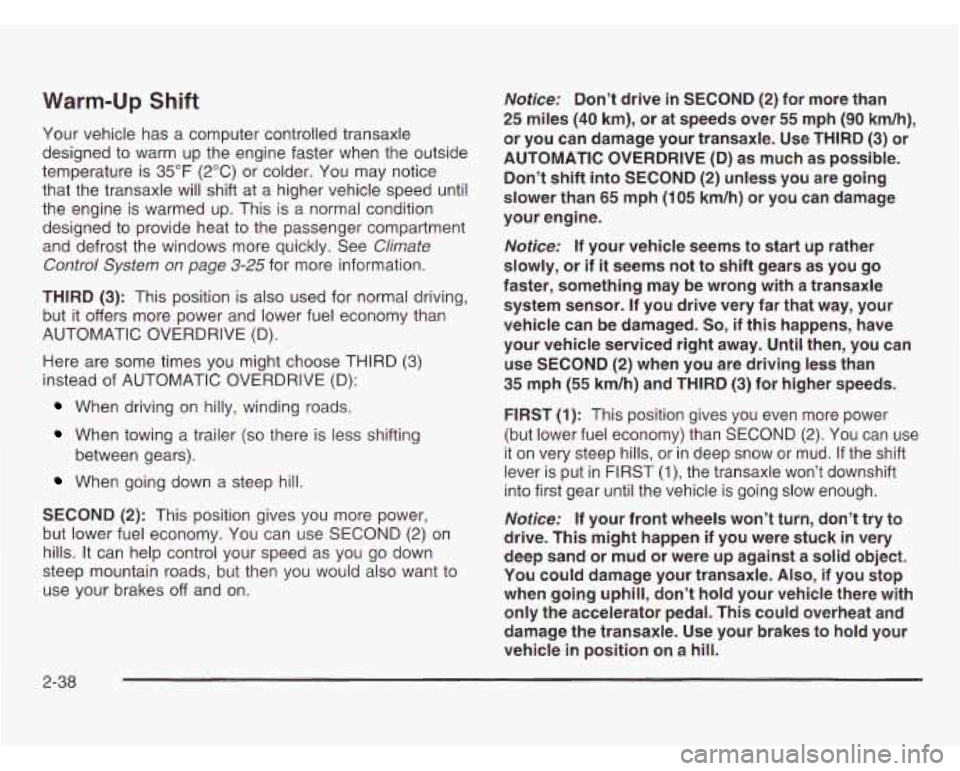
Warm-up Shift
Your vehicle has a computer controlled transaxle
designed to warm up the engine faster when the outside
temperature is
35°F (2°C) or colder. You may notice
that the transaxle will shift at a higher vehicle speed until
the engine is warmed up. This is a normal condition
designed to provide heat to the passenger compartment
and defrost the windows more quickly. See
Climate
Control System on
page 3-25 for more information.
THIRD
(3): This position is also used for normal driving,
but it offers more power and lower fuel economy than
AUTOMATIC OVERDRIVE (D).
Here are some times you might choose THIRD
(3)
instead of AUTOMATIC OVERDRIVE (D):
When driving on hilly, winding roads.
When towing a trailer (so there is less shifting
When going down a steep hill. between gears).
SECOND
(2): This position gives you more power,
but lower fuel economy. You can use SECOND
(2) on
hills. It can help control your speed as you go down
steep mountain roads, but then you would also want to
use your brakes
off and on.
Notice: Don’t drive in SECOND (2) for more than
25 miles (40 km), or at speeds over 55 mph (90 km/h),
or you can damage your transaxle. Use THIRD
(3) or
AUTOMATIC OVERDRIVE (D) as much as possible.
Don’t
shift into SECOND (2) unless you are going
slower than
65 mph (105 km/h) or you can damage
your engine.
Notice: If your vehicle seems to start up rather
slowly, or if
it seems not to shift gears as you go
faster, something may be wrong with a transaxle
system sensor. If you drive very far that way, your
vehicle can be damaged.
So, if this happens, have
your vehicle serviced
right away. Until then, you can
use SECOND
(2) when you are driving less than
35 mph (55 km/h) and THIRD (3) for higher speeds.
FIRST
(1): This position gives you even more power
(but lower fuel economy) than
SECOND (2). You can use
it on very steep hills, or in deep snow or mud.
If the shift
lever is put in FIRST
(I), the transaxle won’t downshift
into first gear until the vehicle is going slow enough.
Notice: If your front wheels won’t turn, don’t try to
drive. This might happen if you were stuck in very
deep sand or mud or were up against a solid object.
You could damage your transaxle. Also, if you stop
when going
uphill, don’t hold your vehicle there with
only the accelerator pedal. This could overheat and
damage the transaxle. Use your brakes to hold your
vehicle in position on a
hill.
2-38
Page 124 of 466
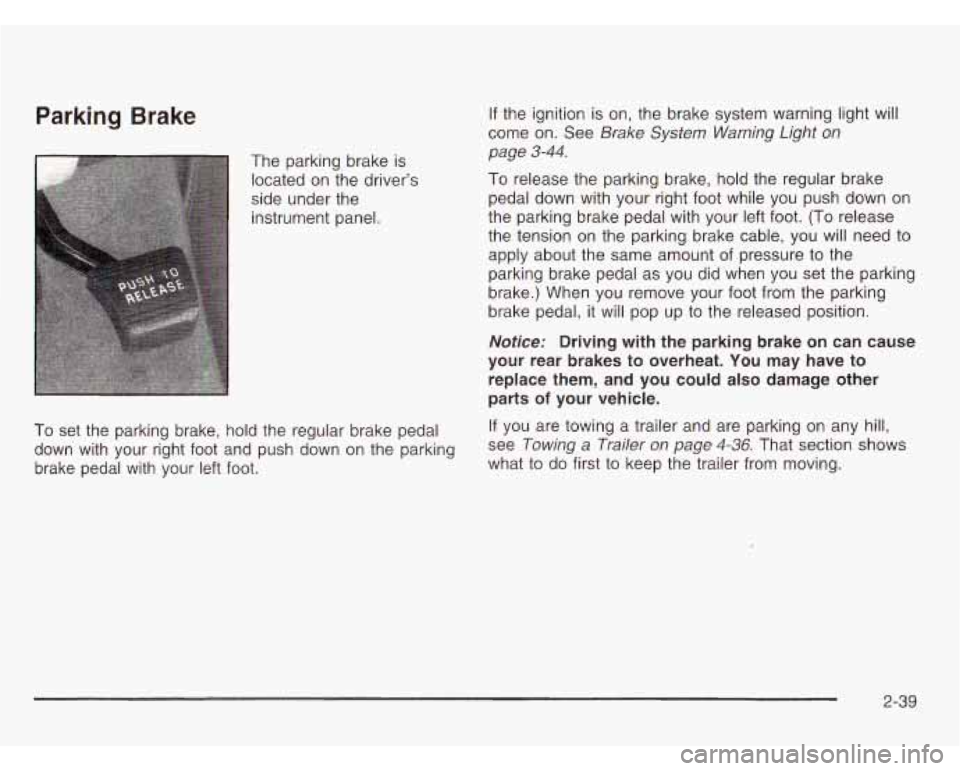
Parking Brake
The parking brake is
located on the driver’s
side under the
instrument panel.
If the ignition is on, the brake system warning light will
come on. See
Brake System Warning Light on
page 3-44.
To release the parking brake, hold the regular brake
pedal down with your right foot while you push down on
the parking brake pedal with your left foot. (To release
the tension on the parking brake cable, you will need to
apply about the same amount of pressure to the
parking brake pedal as you did when you set the parking
brake.) When you remove your foot from the parking
brake pedal,
it will pop up to the released position.
Notice: Driving with the parking brake on can cause
your rear brakes to overheat. You may have to
replace them, and you could also damage other
parts
of your vehicle.
To set the parking brake, hold the regular brake pedal If
you are towing a trailer and are parking on any
hill,
brake pedal with your left foot. what
to do first to keep the trailer from moving.
down with your right foot
and push down on the parking see
Towing a Trailer on page 4-36, That section shows
2-39
Page 127 of 466
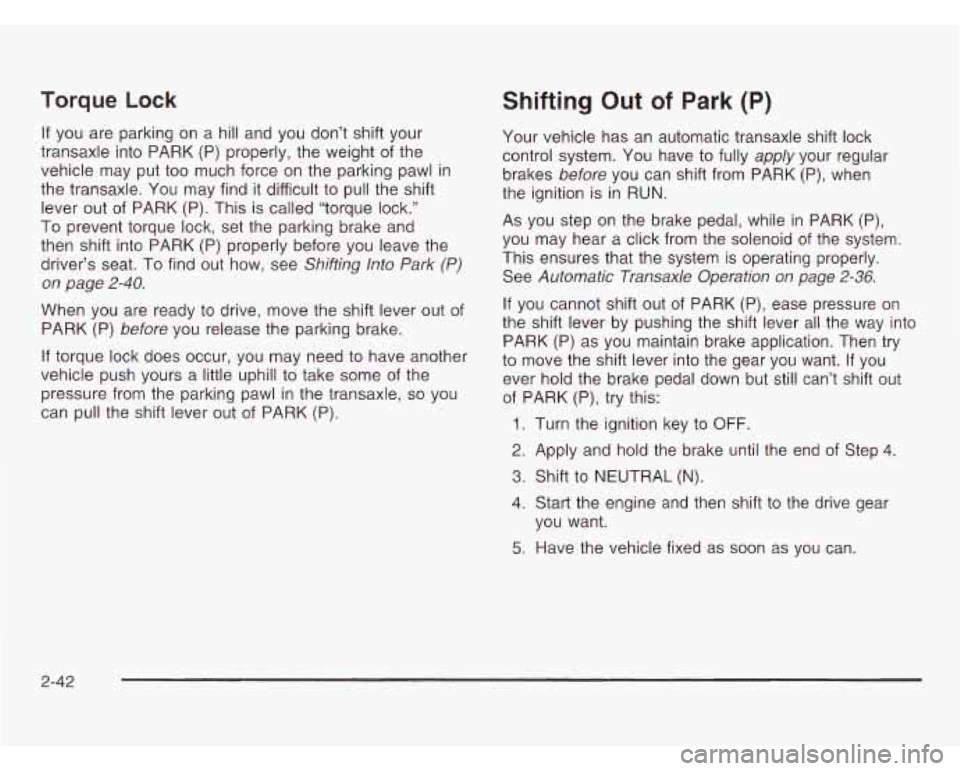
Torque Lock
If you are parking on a hill and you don’t shift your
transaxle into PARK (P) properly, the weight of the
vehicle may put too much force on the parking pawl in
the transaxle. You may find it difficult to pull the shift
lever out of PARK (P). This is called “torque lock.”
To prevent torque lock, set the parking brake and
then shift into PARK (P) properly before you leave the
driver’s seat. To find out how, see
Shifting lnto Park (P)
on page 2-40.
When you are ready to drive, move the shift lever out of
PARK (P)
before you release the parking brake.
If torque lock does occur, you may need to have another
vehicle push yours a little uphill to take some of the
pressure from the parking pawl in the transaxle,
so you
can pull the shift lever out of PARK (P).
Shifting Out of Park (P)
Your vehicle has an automatic transaxle shift lock
control system. You have to fully
apply your regular
brakes
before you can shift from PARK (P), when
the ignition is in RUN.
As you step on the brake pedal, while in PARK (P),
you may hear a click from the solenoid of the system.
This ensures that the system is operating properly.
See
Automatic Transaxle Operation on page 2-36.
If you cannot shift out of PARK (P), ease pressure on
the shift lever by pushing the shift lever all the way into
PARK (P) as you maintain brake application. Then try
to move the shift lever into the gear you want. If you
ever hold the brake pedal down but still can’t shift out
of PARK (P), try this:
1. Turn the ignition key to OFF
2. Apply and hold the brake until the end of Step 4.
3. Shift to NEUTRAL (N).
4. Start the engine and then shift to the drive gear
you want.
5. Have the vehicle fixed as soon as you can.
2-42
Page 167 of 466
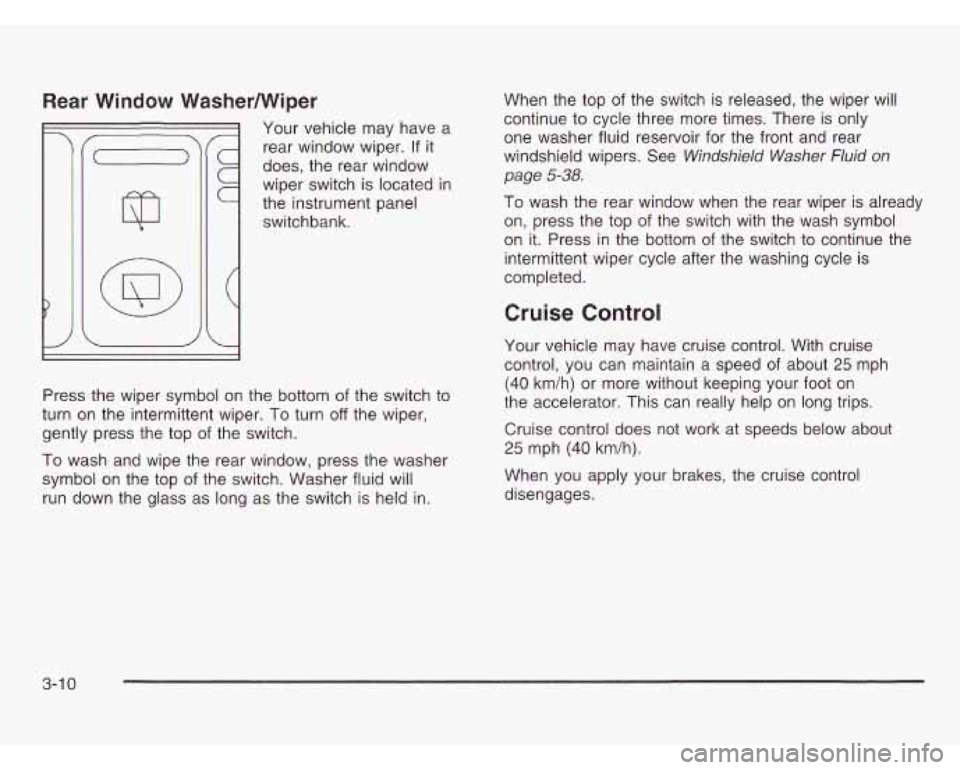
Rear Window WasherNViper
Your vehicle may have a
rear window wiper. If it
does, the rear window
wiper switch is located
in
the instrument panel
switchbank.
i
1
Press the wiper symbol on the bottom of the switch to
turn on the intermittent wiper.
To turn off the wiper,
gently press the top of the switch.
To wash and wipe the rear window, press the washer
symbol on the top of the switch. Washer fluid will
run down the glass as long as the switch is held in. When
the top
of the switch is released, the wiper will
continue to cycle three more times. There is only
one washer fluid reservoir for the front and rear
windshield wipers. See
Windshield Washer Fluid on
page
5-38.
To wash the rear window when the rear wiper is already
on, press the top
of the switch with the wash symbol
on it. Press in the bottom of the switch to continue the
intermittent wiper cycle after the washing cycle is
completed.
Cruise Control
Your vehicle may have cruise control. With cruise
control, you can maintain a speed of about
25 mph
(40 km/h) or more without keeping your foot on
the accelerator. This can really help on long trips.
Cruise control does not work at speeds below about
25 mph (40 km/h).
When you apply your brakes, the cruise control
disengages.
3-1 0
Page 180 of 466
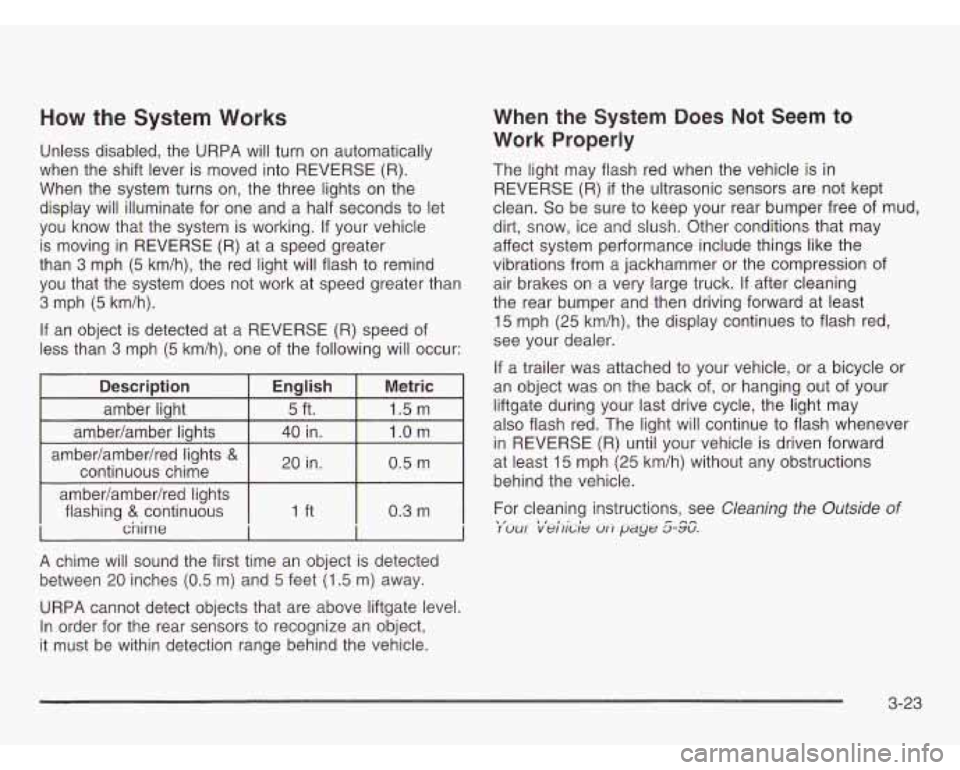
How the System Works
Unless disabled, the URPA will turn on automatically
when the shift lever is moved into REVERSE (R).
When the system turns on, the three lights on the
display will illuminate for one and a half seconds to let
you know that the system is working. If your vehicle
is moving in REVERSE (R) at a speed greater
than
3 mph (5 km/h), the red light will flash to remind
you that the system does not work at speed greater than
3 mph (5 km/h).
If an object is detected at a REVERSE (R) speed of
less than
3 mph (5 km/h), one of the following will occur:
Description
1.5 m 5 ft.
amber light Metric
English I - I
ambedamber lights
0.5 m
continuous chime 1.0 m 40 in.
ambedambedred lights
& 20 in.
1 ambedambedred lights
chime I I
A chime will sound the first time an object is detected
between
20 inches (0.5 m) and 5 feet (1.5 m) away.
flashing
& continuous I 0.3 m
L
When
the System Does Not Seem to
Work Properly
The light may flash red when the vehicle is in
REVERSE (R) if the ultrasonic sensors are not kept
clean.
So be sure to keep your rear bumper free of mud,
dirt, snow, ice and slush. Other conditions that may
affect system performance include things like the
vibrations from a jackhammer or the compression of
air brakes on a very large truck. If after cleaning
the rear bumper and then driving forward at least
15 mph
(25 km/h), the display continues to flash red,
see your dealer.
If a trailer was attached to your vehicle, or a bicycle or
an object was on the back of, or hanging out of your
liftgate during your last drive cycle, the light may
also flash red. The light will continue to flash whenever
in REVERSE (R) until your vehicle is driven forward
at least 15 mph (25 km/h) without any obstructions
behind the vehicle.
For cleaning instructions, see
Cleaning the Outside of .I- I#-#-. I UUI vellrdc oli p/ayt. a-rv. r
URPA cannot detect objects that are above liftgate level.
In order for the rear sensors to recognize an object,
it must be within detection range behind the vehicle.
3-23
Page 202 of 466

If the light is still on, have the vehicle towed for service.
See
Anti-Lock Brake System Warning Light on
F e 3-45 and Towing \’ rr Vehicle on page 4-32.
Your brake system may not be working
properly
if the brake system warning light is
on. Driving with the brake system warning light
on can lead to an accident.
If the light is still
on after you’ve pulled
off the road and stopped
carefully, have the vehicle towed for service.
r
Anti-Lock Brake System
Warning Light
Your vehicle may have
this light. If it does, the
anti-lock brake system
warning light should come
on for
a few seconds
when you turn the ignition
key to RUN.
If the anti-lock brake system warning light stays on
longer than normal after you’ve started your engine, turn
the ignition
off. Or, if the light comes on and stays on
when you’re driving, stop as soon as possible and turn
the ignition
off. Then start the engine again to reset
the system. If the light still stays on, or comes on again
while you’re driving, the anti-lock brake system needs
service and you don’t have anti-lock brakes.
-I -I. I- .I I^ .-,.- -..-I __.^___ :--. l:-.LL -L-..l-l -^-_ I I le dl Ill-IWGK UldKt: byblW i I vval I 111 ly llYl11 31 lwuiu bWl I IC
on briefly when you turn the ignition key to RUN.
If the light doesn’t come on then, have it fixed so it will
be ready to warn you if there
is a problem.
3-45
Page 203 of 466
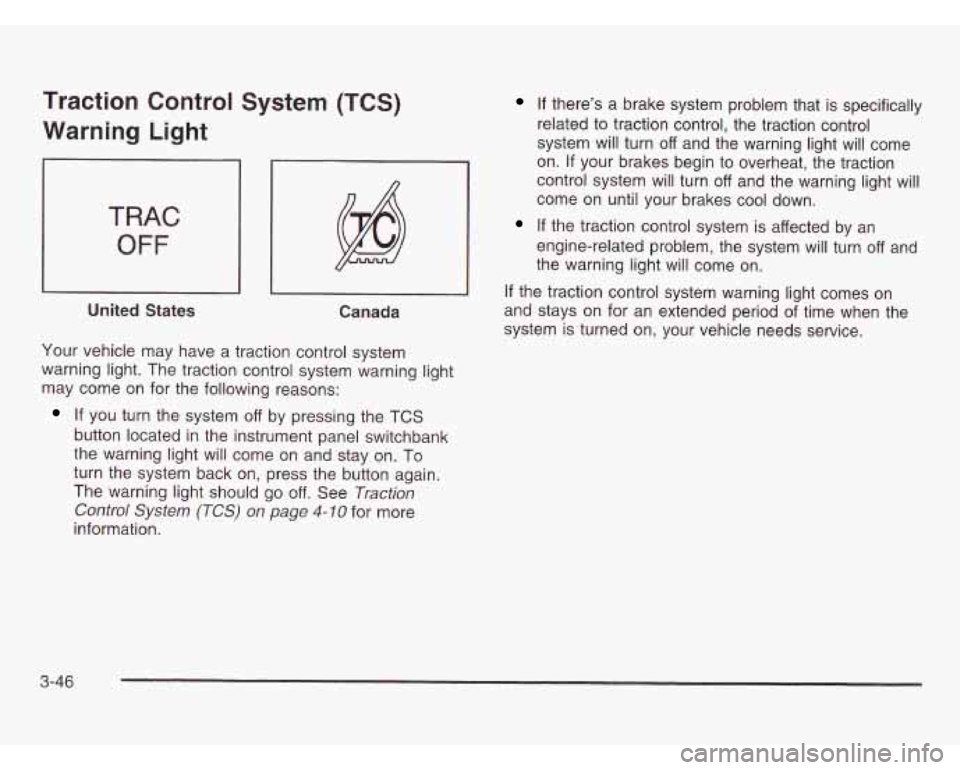
Traction Control System (TCS)
Warning Light
TRAC
OFF
United States Canada
Your vehicle may have a traction control system
warning light. The traction control system warning light
may come on for the following reasons:
If you turn the system off by pressing the TCS
button located in the instrument panel switchbank
the warning light will come on and stay on.
To
turn the system back on, press the button again.
The warning light should go
off. See Traction
Control System
(TCS) on page 4-10 for more
information.
If there’s a brake system problem that is specifically
related to traction control, the traction control
system will turn off and the warning light will come
on.
If your brakes begin to overheat, the traction
control system will turn
off and the warning light will
come on until your brakes cool down.
If the traction control system is affected by an
engine-related problem, the system will turn
off and
the warning light will come on.
If the traction control system warning light comes on
and stays on for an extended period of time when the
system is turned on, your vehicle needs service.
3-46
Page 209 of 466
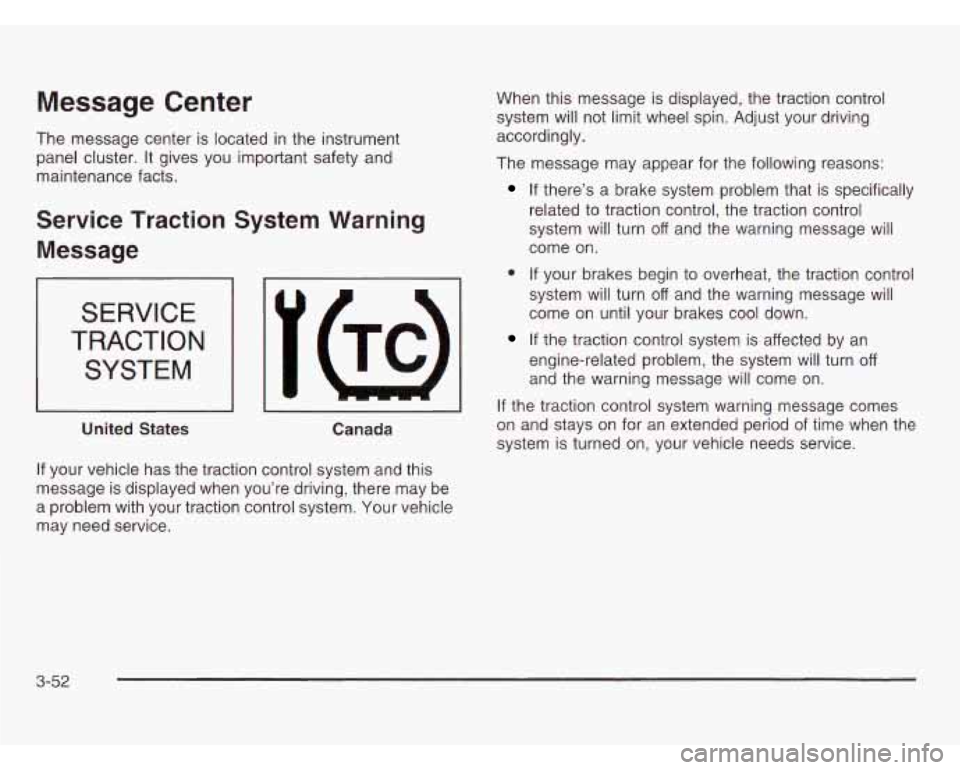
Message Center
The message center is located in the instrument
panel cluster.
It gives you important safety and
maintenance facts.
Service Traction System Warning
Message
SERVICE
TRACTION
SYSTEM
United States
I I
Canada When
this message is displayed, the traction control
system will not limit wheel spin. Adjust your driving
accordingly.
The message may appear for the following reasons:
If there’s a brake system problem that is specifically
related to traction control, the traction control
system will turn
off and the warning message will
come on.
e If your brakes begin to overheat, the traction control
system will turn
off and the warning message will
come on until your brakes cool down.
engine-related problem, the system will turn off
and the warning message will come on.
If the traction control system warning message comes
on and stays on for an extended period of time when the
system is turned on, your vehicle needs service.
If the traction control system is affected by an
If your vehicle has the traction control system and this
message is displayed when you’re driving, there may be
a problem with your traction control system. Your vehicle
may need service.
3-52
Page 269 of 466
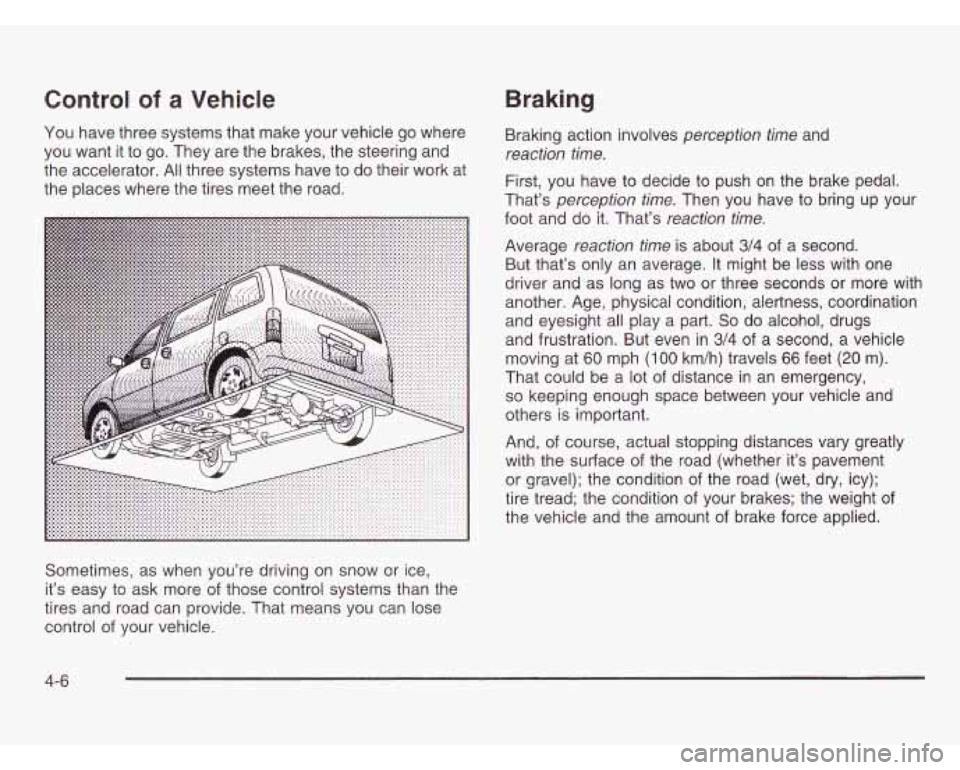
Control of a Vehicle
You have three systems that make your vehicle go where
you want it to go. They are the brakes, the steering and
the accelerator. All three systems have to do their work at
the places where the tires meet the road.
Sometimes, as when you’re driving on snow or ice,
it’s easy to ask more
of those control systems than the
tires and road can provide. That means you can lose
control
of your vehicle.
Braking
Braking action involves perception time and
reaction time.
First, you have to decide to push on the brake pedal.
That’s
perception time. Then you have to bring up your
foot and do it. That’s
reaction time.
Average reaction time is about 3/4 of a second.
But that’s only an average. It might be less with one
driver and as long as two or three seconds or more with
another. Age, physical condition, alertness, coordination
and eyesight all play a part.
So do alcohol, drugs
and frustration. But even in 3/4 of a second, a vehicle
moving at
60 mph (I00 km/h) travels 66 feet (20 m).
That could be a lot of distance in an emergency,
so keeping enough space between your vehicle and
others is important.
And, of course, actual stopping distances vary greatly
with the surface of the road (whether it’s pavement
or gravel); the condition of the road (wet, dry, icy);
tire tread; the condition
of your brakes; the weight of
the vehicle and the amount of brake force applied.
4-6